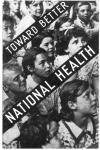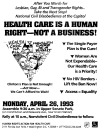Health care reform and social movements in the United States
- PMID: 18687625
- PMCID: PMC2518596
- DOI: 10.2105/ajph.98.supplement_1.s69
Health care reform and social movements in the United States
Abstract
Because of the importance of grassroots social movements, or "change from below," in the history of US reform, the relationship between social movements and demands for universal health care is a critical one. National health reform campaigns in the 20th century were initiated and run by elites more concerned with defending against attacks from interest groups than with popular mobilization, and grassroots reformers in the labor, civil rights, feminist, and AIDS activist movements have concentrated more on immediate and incremental changes than on transforming the health care system itself. However, grassroots health care demands have also contained the seeds of a wider critique of the American health care system, leading some movements to adopt calls for universal coverage.
Figures




Republished from
-
Health care reform and social movements in the United States.Am J Public Health. 2003 Jan;93(1):75-85. doi: 10.2105/ajph.93.1.75. Am J Public Health. 2003. PMID: 12511390 Free PMC article.
Similar articles
-
Health care reform and social movements in the United States.Am J Public Health. 2003 Jan;93(1):75-85. doi: 10.2105/ajph.93.1.75. Am J Public Health. 2003. PMID: 12511390 Free PMC article.
-
Policy challenges in US health care system reform.J Health Care Finance. 2010 Spring;36(3):34-46. J Health Care Finance. 2010. PMID: 22329329
-
Human rights from the grassroots up: Vermont's campaign for universal health care.Health Hum Rights. 2012 Jun 15;14(1):E106-18. Health Hum Rights. 2012. PMID: 22773094
-
Harry and Louise go to Washington: political advertising and health care reform.J Health Polit Policy Law. 1996 Spring;21(1):35-68. doi: 10.1215/03616878-21-1-35. J Health Polit Policy Law. 1996. PMID: 8708342 Review.
-
Evolution of US Health Care Reform.Pain Physician. 2017 Mar;20(3):107-110. Pain Physician. 2017. PMID: 28339426 Review.
Cited by
-
Payor Type is Associated With Increased Rates of Reoperation and Health-care Utilization Following Unicompartmental Knee Arthroplasty: A National Database Study.Arthroplast Today. 2022 Dec 27;19:101074. doi: 10.1016/j.artd.2022.101074. eCollection 2023 Feb. Arthroplast Today. 2022. PMID: 36605496 Free PMC article.
-
Health Justice: A Framework for Mitigating the Impacts of HIV and COVID-19 on Disproportionately Affected Communities.Am J Public Health. 2023 Feb;113(2):194-201. doi: 10.2105/AJPH.2022.307139. Epub 2022 Dec 15. Am J Public Health. 2023. PMID: 36521095 Free PMC article.
-
The Health of Mothers of Adult Children with Serious Conditions.J Marriage Fam. 2022 Jun;84(3):734-751. doi: 10.1111/jomf.12823. Epub 2022 Jan 28. J Marriage Fam. 2022. PMID: 35990797 Free PMC article.
-
Beyond Barriers: Achieving True Equity in Cancer Care.Curr Oncol. 2025 Jun 12;32(6):349. doi: 10.3390/curroncol32060349. Curr Oncol. 2025. PMID: 40558292 Free PMC article. Review.
References
-
- On social movements and grass-roots activism, see Tarrow Sidney, Power in Movement: Social Movements, Collective Action and Politics (Cambridge, England: Cambridge University Press, 1994); Marco Guigni, Doug McAdam, and Charles Tilly, eds, How Social Movements Matter (Minneapolis: University of Minnesota Press, 1999); Temma Kaplan, Crazy for Democracy: Women in Grass-roots Movements (New York: Routledge, 1997).
-
- From 1943 to 1965, opinion polls showed that “a relatively stable two-thirds majority of Americans” favored “some government role in the financing of personal health services”; Marmor Theodore, The Politics of Medicare (London: Routledge, 1970), 3. See also Lawrence Jacobs, The Health of Nations: Public Opinion and the Making of British and American Health Policy (Ithaca, NY: Cornell University Press, 1993); Reuters, “Poll finds momentum for radical health care reform,” August 26, 2002, available at: http://www.ada.org/prof/pubs/daily/0208/0826us.html. Accessed October 22, 2002.
-
- Numbers Ronald, Almost Persuaded: American Physicians and Compulsory Health Insurance, 1912–1920 (Baltimore: Johns Hopkins University Press, 1978); Beatrix Hoffman, The Wages of Sickness: The Politics of Health Insurance in Progressive America (Chapel Hill: University of North Carolina Press, 2001), chap 4.
-
- Hoffman, Wages of Sickness, chap 7 and 8.
-
- Gordon Colin, Dead on Arrival: Health Care and the Limits of Social Provision in the United States (Princeton, NJ: Princeton University Press, in press), 410; Jonathan Engel, Doctors and Reformers: Discussion and Debate Over Health Policy, 1925–1950 (Columbia: University of South Carolina Press, 2002), chap 2.
LinkOut - more resources
Full Text Sources

